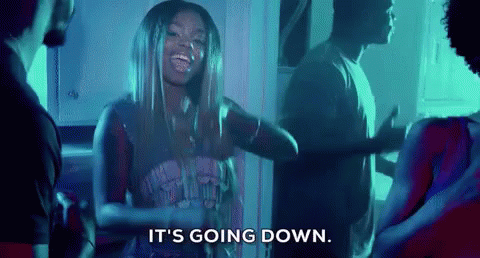With so many social platforms to manage, it can be tempting to post to all social media at once. Is this possible? Technically yes. Is it a best practice? Not exactly.
With the right tools in place, you absolutely can schedule your content to multiple social media accounts at once — as long as you proceed with caution.
Here’s everything you need to know to keep your social media presence looking professional along the way.
Bonus: Download our free, customizable social media calendar template to easily plan and schedule all your content in advance.
As you may have gathered by now, posting to all your social media accounts is, in general, not great for your marketing strategy.
We’ll get into the pros and cons throughout this post (as well as how you can mitigate some of the cons). It really all boils down to one key concept:
To get the maximum return on effort (and investment), you need to be active on the right social networks in the right way to reach your target audience while also appealing to each network’s unique audience, specs, and algorithms.
It’s a bit of a balancing act.
Does this mean you need to start from scratch for every account? No!
While blast-posting is not a wise strategy, you can absolutely use the same content assets to post to multiple social media accounts at once – and with the right tools in place, you can do it all from one screen. (Phew!)
#1 Social Media Tool
Create. Schedule. Publish. Engage. Measure. Win.
Free 30-Day Trial
1. Different platforms have different audiences
You probably know instinctively that the demographics of Facebook users differ significantly from those of the audiences on Snapchat or LinkedIn.
But just how different are they? If you really want to dive into this topic, we’ve got a full post packed with more than 100 demographic data points for the various social platforms.
But here’s a quick visual look at the difference in social platform use among various age demographics in the United States:
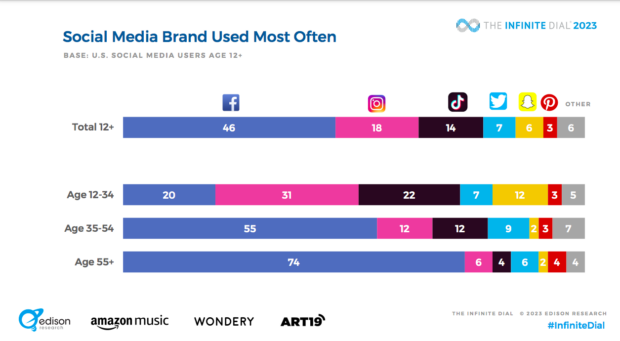
Demographic factors impact the type of content you create for each platform. It doesn’t make sense to talk to high school seniors the same way you talk to senior citizens.
2. People use different platforms for different reasons
It’s also important to consider that the audiences on different social platforms are there for different things.
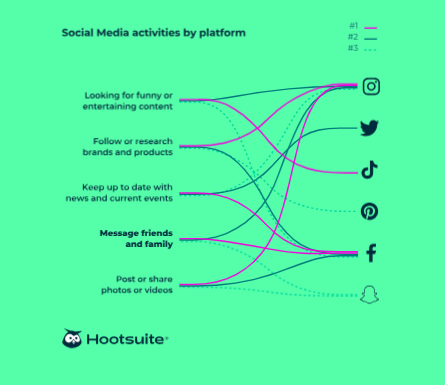
Facebook is the top platform for messaging friends and family and keeping up to date with current events, while Instagram leads for brand research and sharing photos and videos. Meanwhile, TikTok reigns supreme for those looking for funny or entertaining content.
Of course, this also means people expect different things from the brands they follow on different channels. If you share the same post across all platforms, you’re missing out on opportunities to lean into these preferences.
For example, check out how Dominos approached dip-ranking content on on differently X and TikTok:
Finally, consider that almost all social media users have accounts on multiple platforms. For example, more than 84% of TikTok users also have Facebook accounts.
If people do follow you on multiple platforms, they’ll be annoyed to see the exact same content multiple times.
3. Different audiences are active at different times
It’s a big world out there, and you can’t assume that all of your audience is online at the times that are most convenient for you to post. You need to understand the best time to post to each platform to reach the largest share of your audience.
For example, look at these heatmaps from Hootsuite Analytics showing the times followers are online for Facebook and TikTok for a sample business.
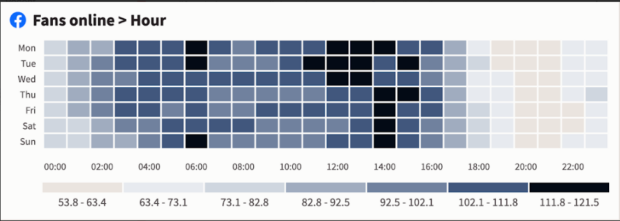
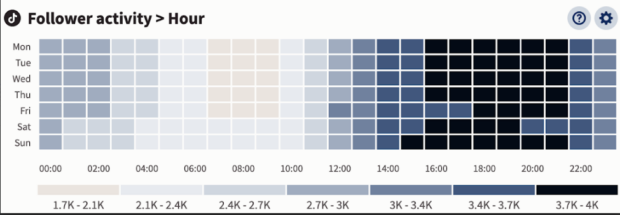
If this business posted to both platforms at the same time, they’d miss their peak times on one or both accounts.
Staggering your posts gives you the best visibility and the best chances for early engagement. Early engagement is a critical signal to most social media algorithms, so this also gives you the best potential to expand your audience.
On that note…
4. Each platform’s algorithm is different
Posting the same content for each channel, without optimizing for that channel’s particular algorithm, reduces the effectiveness of your content on all channels.
Even the different surface algorithms within one platform can differ.
And to make it even more complicated, those algorithms are constantly changing.
While none of the social media platforms reveal exactly how their algorithms work, they’ve all become more open about the ranking signals they use to surface content. We dig into the details for you in our guide to the algorithms on every social platform.
5. Networks have unique image specs and character limits
The requirements for social media platforms can vary widely. Every channel has a unique set of posting specs, such as:
- image/video file size
- image/video aspect ratio
- minimum and maximum pixel requirements
- copy length/character count
- link inclusion
- tagging functionality
For example, Instagram favors vertical video. Facebook Reels requires vertical video, but horizontal can work for Facebook feed. And YouTube is all about horizontal video … unless you’re posting to YouTube Shorts.
Posting the right specs to the right platforms allows your fans to see your content the way you intended, which will maximize engagement.
<h36. Each platform offers different social search functionality
As social search becomes ever-more important, it’s also important to understand the search engine optimization (SEO) requirements for each platform. These differ from the algorithm factors and can include things like:
And, of course, you can’t assume that the same keywords and hashtags will work for SEO across platforms. (Remember that people use different platforms for different reasons and will therefore search differently among them.)
With all of that said, the reality is that social media managers often don’t have time to craft a completely separate set of content for each platform. Fortunately, there is a way to easily fill up your social media calendar, save time, and customize the same content for the requirements of each platform.
You might have guessed by now that a social media management tool like Hootsuite can make this happen. As you create a post, Hootsuite shows you the requirements of each channel and allows you to create multiple versions with just a few clicks, so you always have the best chance for success.
Here’s how to post on all social media at once while customizing your content to each platform.
Connect your social channels to Hootsuite
Connect your brand’s Facebook, LinkedIn, X (formerly Twitter), Instagram, YouTube, TikTok, and Pinterest accounts to your Hootsuite dashboard to ensure full coverage for each of the major social media networks.
After you’ve logged in to the Hootsuite dashboard (or signed up!), follow these steps to manage accounts on behalf of an organization:
1. Click Social accounts and teams to go to your Accounts and Teams Page

2. Click Manage

3. Under Social Networks I Have Access To, click Add a social network

4. Choose the account to add:

5. Enter your credentials and sign in
If you’re using Hootsuite as an individual, just click Add social account.
Continue to add profiles until you’ve connected all your social media accounts to Hootsuite’s platform.
Create your social posts
Now you’re ready to post to all social media at once using a single social media post template that you can repurpose for each channel.
1. Click on the Create (+) icon on the left side of your Hootsuite dashboard, then click Post.
2. Under Publish to, select the drop-down menu, and choose the channels you want your post to appear on.

3. Add your social post copy into the New post planner under Your post, and add images or video via the Media section. This is a good time to save your work as a draft!

4. You’ll then need to edit and optimize each post for the channel you are posting on. To do so, click on the network’s logo (next to Your post), and add hashtags, image alt text, or location tags that are relevant to each platform.
Use the built-in character count guides to make sure your caption is the right length, and take advantage of the built-in photo editor and Canva integration to resize images and adapt content.

Schedule and publish your social media posts
Now that you’ve crafted social media posts for each channel, you’re ready to get ‘em live!
1. If you’re ready to publish immediately, click Post now in the bottom right corner of the screen.
2. Alternatively, click Schedule for later to select a date and time to post your content, and then click Schedule.
If you’re scheduling your posts for later, use Hootsuite’s recommendations for the best times to post. They are based on your accounts’ historical engagement and reach data and will help you post at a time when your followers are most likely to engage with your content.

And that’s it! It really couldn’t be easier to post to social media all at once using Hootsuite.
Or could it? If you’re scheduling a large volume of social posts, you might want to check out Hootsuite’s bulk social media scheduling feature. This allows you to upload and schedule up to 350 social posts at the same time.
We recommend doing a full-on sanity check of your posts before hitting the publish or schedule button. Here are a few nuggets to look out for.
Is the copy the right length?
It goes without saying that the copy you write for one channel might not fit onto another:
- X (formerly Twitter) has a maximum character limit of 280
- Facebook posts are max 63,206 characters
- Instagram posts are max 2,200 characters
- LinkedIn posts are max 3,000 characters
- YouTube descriptions are max 5,000 characters
- TikTok captions are max 2,200 characters
- Pinterest description are max 500 characters
Of course, the maximum character count is not necessarily the best character count. Check out our post on the ideal post length for each platform and optimize accordingly. If you need help generating your captions, try using OwlyWriter AI.
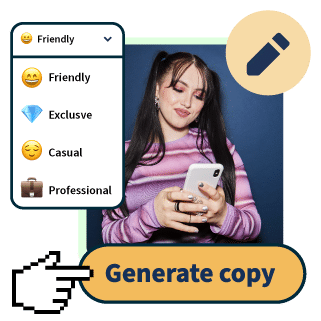
Craft perfect posts in seconds
OwlyWriter AI instantly generates captions and content ideas for every social media network. It’s seriously easy.
Start free 30-day trial
Are your photos and videos the right size?
Make sure you know the exact dimensions your images and videos need to be for each social platform. This keeps your content looking professional and eye-catching.
We’ve got all the detailed secs in our post on social media image sizes for every network, but here’s a helpful cheat sheet to get you started:

Pro tip: Use Hootsuite’s in-dashboard photo editor to adjust the size of your images to the right dimensions for each platform before publishing. You can also get creative with the Canva integration to create appropriately sized designs. These are easy ways to make sure all images are both the right size and on-brand!
Does the content match the channel?
As we mentioned earlier, different channels have different audiences. Make sure your social media posts will resonate with the audience you’re speaking to. You can use Hootsuite Analytics to track your performance across channels and gain insights about what types of content work best for you on each platform.
Here are a few specific details to check:
- Hashtags: Make sure to double-check that the hashtags you’ve used are relevant to the platform. For example, we’re not big fans of #fyp, but if you are going to use it, make sure you only use it for TikTok. Likewise, any hashtag starting with #Insta should only be used for Instagram.
- Lingo: For example, you don’t want to ask Instagram users to Retweet or subscribe. Understand the lingo of each platform to make sure you’re phrasing your captions and calls to action effectively.
- Links: If you can post a link directly, do so (using UTM parameters through the Owl.ly link shortener). There’s no point directing Facebook users to your link in bio.
Have you tagged the right accounts?
Nothing is worse than crafting the perfect social post, especially with a brand partner, only to tag the wrong account. People and brands can use variations of their handles on different platforms, so double-check to make sure you have it right.
For example, the podcast My Favorite Murder is @myfavoritemurder on Facebook and Instagram but @myfavmurder on X.
This is an easy customization within the Hootsuite editing tool. Keep your content looking professional by always double-checking your tags.
Use Hootsuite to schedule all of your social media posts, engage with your followers, and track the success of your efforts. Sign up for a free trial today.



/cdn.vox-cdn.com/uploads/chorus_asset/file/25503647/DSCF7835_Enhanced_NR.jpg)



